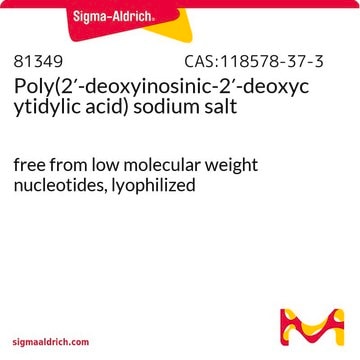03353591910
Roche
DIG Gel Shift Kit, 2nd generation
storage temp.:-20°C (-15°C to -25°C)
About This Item
Productos recomendados
description
New formulation containing Terminal Transferase, recombinant.
Quality Level
manufacturer/tradename
Roche
greener alternative product characteristics
Designing Safer Chemicals
Learn more about the Principles of Green Chemistry.
sustainability
Greener Alternative Product
greener alternative category
, Aligned
shipped in
dry ice
storage temp.
−20°C (−15°C to −25°C)
General description
DIG Gel Shift Kit employs recombinant terminal transferase and digoxigenin (DIG)-11- dideoxyuridine triphosphate (ddUTP) makes the labeling reaction very flexible. It can be used to label the 3′ ends of any oligonucleotide (whether it has a 5′- overhanging end, a 3′-overhanging end, or blunt ends). Both single- and double-stranded DNA can be labeled.
Application
Features and Benefits
- Convenient, since the technique does not require special equipment or technology.
- Reproducible, since DIG-labeled probes are stable indefinitely.
- Safe, because the assay is nonradioactive.
- Reliable, because the kit provides DIG-labeled control oligonucleotides to establish that the assay is working.
- Function-tested with the controls provided in the kit (See "Quality").
- Sensitive, since the kit can detect as little as 20fmol of the control oligonucleotide (after it is labeled according to the kit protocol).
Packaging
Physical form
Preparation Note
Sample
Amount: 3.85pmol or 100ng
Type: Oligonucleotides with 5′-overhanging ends, 3′-overhanging ends, or blunt ends; single- or double-stranded DNA fragments (30 - 200bp)
Note: Ideally, fragments to be labeled should be between 30 and 100bp.
Time required
Oligonucleotide annealing and labeling: 10minutes
Formation of oligonucleotide-protein complexes: 25minutes
Electrophoresis: 1 hour to overnight, depending on electrophoresis system
Blotting: 1 - 2 hours
Immunological detection: 2hours
Exposure to X-ray film or imager: 15 - 40minutes
Other Notes
Solo componentes del kit
- Labeling Buffer 5x concentrated
- CoCl<SUB>2</SUB> Solution 25 mM
- DIG-ddUTP Solution, 1 mM Digoxigenin-11-ddUTP
- Recombinant Terminal Transferase 400 U/μl
- Binding Buffer 5x concentrated
- Control Oligonucletide ds 39mer, unlabeled 0.1 μg/μl, 3.85 pmol/μl
- DIG-labeled Control Oligonucleotide ds 39mer 0.4 ng/μl, 15.54 fmol/μl
- Control Factor Oct2A 25-75 ng/μl
- Poly [d(I-C)] 0.1 μg/μl
- Poly [d(A-T)] 0.1 μg/μl
- Poly L-lysine 0.1 μg/μl
- Loading Buffer without bromophenol blue
- Loading Buffer with bromophenol blue
- Anti-Digoxigenin-AP 750 U/ml
- CSPD 10 mg/ml
- Blocking Reagent
signalword
Danger
Hazard Classifications
Acute Tox. 4 Inhalation - Acute Tox. 4 Oral - Aquatic Chronic 2 - Carc. 1B Inhalation - Repr. 1B
Storage Class
6.1D - Non-combustible, acute toxic Cat.3 / toxic hazardous materials or hazardous materials causing chronic effects
wgk_germany
WGK 3
flash_point_f
Not applicable
flash_point_c
Not applicable
Certificados de análisis (COA)
Busque Certificados de análisis (COA) introduciendo el número de lote del producto. Los números de lote se encuentran en la etiqueta del producto después de las palabras «Lot» o «Batch»
¿Ya tiene este producto?
Encuentre la documentación para los productos que ha comprado recientemente en la Biblioteca de documentos.
Los clientes también vieron
Artículos
Digoxigenin (DIG) labeling methods and kits for DNA and RNA DIG probes, random primed DNA labeling, nick translation labeling, 5’ and 3’ oligonucleotide end-labeling.
Protocolos
The DIG Gel Shift Kit uses recombinant terminal transferase and digoxigenin (DIG)-11- dideoxyuridine triphosphate (ddUTP), which makes the labeling reaction flexible.
Nuestro equipo de científicos tiene experiencia en todas las áreas de investigación: Ciencias de la vida, Ciencia de los materiales, Síntesis química, Cromatografía, Analítica y muchas otras.
Póngase en contacto con el Servicio técnico


![Poly[d(I-C)] lyophilized, pkg of 10 U (10108812001 [A<sub>260</sub> units]), pkg of 50 U (11219847001 [A<sub>260</sub> units])](/deepweb/assets/sigmaaldrich/product/images/352/091/ef743cea-ccd8-44f1-8f3b-dec5a1e4f5d1/640/ef743cea-ccd8-44f1-8f3b-dec5a1e4f5d1.jpg)






